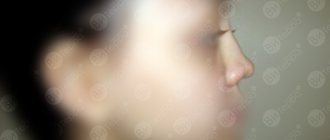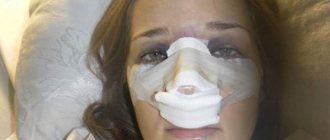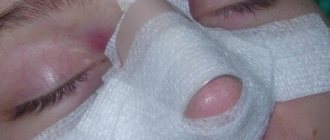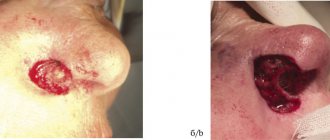Secondary rhinoplasty is corrective surgery of the nose to change the shape or improve the function of the nose after previous rhinoplasty.
The term can be applied to all subsequent nose jobs. The repeat procedure is performed on a nasal frame that has already been surgically altered. For this reason, its implementation can be more technically difficult.
As with primary rhinoplasty, all goals and expectations for the surgery should be carefully discussed with the operating surgeon. A photograph of your nose's former appearance before the initial surgery may be helpful. This is not necessary, but the plastic surgeon may also ask for a description of the previous operation and other medical records about it (epicrisis, previous examinations).
Operation description
Secondary rhinoplasty refers to reconstructive (restorative) surgical interventions. During the operation, surgeons correct mistakes made by other doctors during primary rhinoplasty or eliminate newly encountered defects and complications. Revision rhinoplasty is performed using the open method because the surgeon needs to see the changes that have occurred in the tissues of the nose.
If a large volume of surgical intervention cannot be performed simultaneously, revision rhinoplasty is performed in two stages. There may be a large gap between them, which is necessary to restore the nasal structures. The operation is planned well in advance.
Sometimes patients do not see the difference between revision rhinoplasty and nose correction after primary plastic surgery. The correction is performed by the same surgeon who performed the primary operation. He corrects minor defects on an outpatient basis so that the nose has the perfect shape and size.
When can revision rhinoplasty be done?
A second operation is not possible in all cases. Sometimes it is impossible to correct the consequences of unsuccessful rhinoplasty.
If several competent doctors refused to take on it, then you need to think about whether it’s worth doing. It may be better to try to correct the defect through cosmetic procedures.
In cases where rhinoplasty can be done a second time, it is very important that the tissues heal completely and post-operative swelling goes down. For this to happen , at least a year must pass after the first operation.
Indications
Surgeons at our clinic perform revision rhinoplasty if the following indications exist:
- Patient dissatisfaction with the results of primary plastic surgery;
- The development of complications - perforation of the nasal septum, asymmetry, impaired nasal breathing, subsidence of the nasal dorsum.
In most cases, revision rhinoplasty is insisted on by patients who are dissatisfied with the results obtained. It becomes necessary if the surgeon made a mistake during the initial plastic surgery or the patient did not follow the recommendations during the recovery period. Often the unwanted effects of the initial surgery go away on their own over time. In this case, the patient is advised to be patient and wait for the final result. If there is an objectively unsatisfactory result, a repeat operation is planned. Our surgeons often perform revision rhinoplasty on the tip or dorsum.
When is secondary rhinoplasty necessary?
Repeated surgical correction of the nose is needed in the following cases:
- If complications arise after rhinoplasty that cannot be eliminated by conservative methods, especially if the result of these complications is not only a cosmetic defect, but also impaired respiratory function;
- In case of trauma and other mechanical damage to the nose after rhinoplasty, when this affected the aesthetic result;
- And, unfortunately, another possible case is the correction of the surgeon’s mistakes that were made during a previous operation.
You can also resort to revision rhinoplasty if no aesthetic effect was obtained, objective disharmony of facial features is visible, or the patient categorically does not accept the result.
Problems that require revision rhinoplasty include:
- Nasal airway obstruction, or, simply, difficulty in nasal breathing;
- Destruction of the nasal septum (for example, due to a large hematoma or abscess in this area);
- Recession or damage to the cartilage and bones of the nose;
- Unnatural cosmetic appearance of the nose (“hypercorrection of the nose”);
- The emergence, persistence or worsening of nasal asymmetry;
- Excessive or disproportionate reduction in the height of the bridge of the nose (height of the bridge of the nose), which occurs when removing a hump;
- Incomplete achievement of the cosmetic effect (within limits not limited by the anatomy of the nose);
- Excessive or insufficient definition of the tip of the nose;
- Excessively narrowed tip of the nose (“truncated tip”);
- The formation of bumps on the nose (for example, in the area where the hump was located);
- Excessive internal and/or external scarring (keloid scar) on the skin or mucous membrane.
Contraindications
Doctors at our clinic do not perform revision rhinoplasty if the following contraindications exist:
- Acute infectious or inflammatory disease;
- Diabetes mellitus in the stage of decompensation;
- Blood clotting disorders;
- Oncological diseases.
The operation is not performed on pregnant and breastfeeding women. Surgery is postponed until a patient with a respiratory infection, including coronavirus, recovers. Secondary rhinoplasty is not performed if during the primary operation a large amount of nasal tissue was removed or atrophy occurred in the postoperative period. In this case, surgeons at our clinic restore tissue with implants or autografts.
Are there complications after revision rhinoplasty?
Even with a successful operation, there is a possibility of unforeseen complications. Both the doctor and the patient must be prepared for this. This is due to the fact that previously changed nasal tissues do not respond well to repeated intervention. This can be expressed in the form of various inflammations, implant rejection and other undesirable consequences.
How should the patient react to this? Do not immediately panic and scold the doctor. Not everything depends on him here. Instead of a negative reaction, it is better to make every effort to combat complications and fully follow the recommendations of your doctor.
Prices
| Type of service | Service cost |
| Revision rhinoplasty | 260,000 rub. |
| Rhinoplasty | 200,000 rub. |
| Rhinoseptoplasty | 260,000 rub. |
| Surgical correction of nasal tip deformity, category 1 | 110,000 rub. |
| Surgical correction of nasal tip deformity, category 2 | 120,000 rub. |
| Surgical correction of the wings of the nose, category 1 | 70,000 rub. |
| Surgical correction of the wings of the nose, category 2 | 75,000 rub. |
| Surgical correction of the nasal septum, category 1 | 50,000 rub. |
| Surgical correction of the nasal septum, category 2 | 60,000 rub. |
Show all price
Methods of carrying out the procedure
Depending on the individual characteristics of the patient, the specialist chooses one of two methods of performing revision rhinoplasty:
- Open method. Incisions are made on the outside of the nose and on its mucous membrane. This allows the surgeon to gain extensive access to the surgical area and correct deeper tissues.
- Closed method. Used in cases where minor changes are required. This type of operation is considered easier, rehabilitation does not last long, and the result is more aesthetic and harmonious.
All repeated operations are performed under general anesthesia; the duration of the procedures depends on the amount of work.
Questions
Some patients prematurely conclude that they did not achieve the desired result of primary rhinoplasty and turn to plastic surgeons to undergo revision surgery. There is no need to rush into a repeat nose job. First you should wait for the final result of the primary operation. It can be assessed and visible no earlier than six months or a year later. And only if there is no cosmetic effect can a repeat operation be planned.
For employed citizens of the Russian Federation aged 18 to 75 years, our clinic provides the opportunity to perform the operation in installments. You can get a loan using one of three ways: 1. On the day of your consultation with a plastic surgeon, submit a request directly to our clinic. The bank reviews the application within half an hour; 2. Submit an application to the bank in advance and come to the operation with a ready-made solution; 3. Make a request remotely. After making a positive decision, the bank will send a courier to the client. You will sign the completed contract and pay for the courier services. Banks usually issue loans for a period of six months to three years. The annual overpayment is 10%.
How is rehabilitation after revision rhinoplasty?
The rehabilitation period in this case is approximately twice as long as usual.
The sutures after surgery are removed after about 7 days.
Hematomas disappear within 10–20 days, or even within a month.
But swelling after secondary rhinoplasty goes away only after a few months.
During the first month, you need to be especially careful to:
- Avoid physical activity
- Protect hematomas and sutures from exposure to sunlight
- Avoid impacts and shocks
- Sleep only on your back with your head slightly elevated
- Eat and drink only something warm
- Eliminate alcohol and tobacco
- Do not take a hot bath, do not go sunbathing, do not visit a solarium or sauna.
- Don't wear glasses
- Carry out all prescribed procedures regularly
One year after the operation , the patient's tissues have usually healed completely, and the patient can evaluate the final results.
Revision rhinoplasty: how to correct the results of an unsuccessful operation
The size, shape and proportions of our nose significantly affect the overall attractiveness and harmony of the face. That is why, even after successful rhinoplasty, a significant part of patients remain dissatisfied with what happened. What can we say about cases when the operation was not entirely successful...
Repeated (secondary) rhinoplasty is a surgical intervention aimed at correcting mistakes made during the first operation, eliminating complex defects, and correcting an unsatisfactory result. Technically, such plastic surgery is considered more complex than primary plastic surgery and requires the highest qualifications from the surgeon performing it.
In what cases and in what ways is it carried out? Can it solve all problems? How much will it cost the patient and what will the price depend on? TecRussia.ru examines the main subtleties and nuances:
↑ Differences between primary and secondary rhinoplasty
- Primary surgery is performed to solve aesthetic problems (congenital or acquired, for example, as a result of injury) - it is resorted to by patients who are dissatisfied with the size or shape of their nose, the presence of noticeable defects in the form of bumps, dips, curvatures, etc.
- Secondary rhinoplasty is “working on the mistakes” made during the primary correction, correcting the overall unsatisfactory result and eliminating complications that appeared during the rehabilitation period.
- Some particularly complex rhinosurgeries are initially planned and carried out in two stages, with a fairly large interval, so that the patient’s body has time to recover.
- Repeated rhinoplasty is often confused with corrective rhinoplasty. In the first case, we are talking about a full-fledged and, as a rule, very complex operation aimed at correcting serious defects. The second option is an ordinary “revision”, which is carried out quickly and, often, on an outpatient basis. Its goal is to correct minor imperfections that have formed during the healing process. According to statistics, every third patient needs it, regardless of the experience and qualifications of his surgeon.
| Photos before and after correcting the consequences of an unsuccessful nose job: | |
It is important for patients to understand that secondary rhinoplasty does not guarantee complete elimination of all defects, especially if during the primary intervention too much bone and cartilage tissue was removed, implants were used, scar tissue or necrosis formed, etc.
The process is also complicated if the surgeon is not fully informed if the operations are performed by different specialists. The second doctor has to carry out the intervention almost “by touch”, since the subcutaneous components could have changed dramatically as a result of the primary intervention. The main task of the specialist in this case is not to harm the patient even more . Whether it will be possible to correct all or at least some functional and aesthetic defects is decided in each case individually.
↑ How soon can revision rhinoplasty be done? Main indications for use
Several factors or a combination of them may lead to the need to perform a second operation:
- Mistakes made by the surgeon during the initial correction.
- Violation of recommendations by the patient during the rehabilitation period.
- Development of postoperative complications.
- Subsequent injuries and mechanical damage to the nose.
- The need to divide a complex intervention into 2 stages.
At the same time, it is possible to evaluate the result of the primary operation and raise the question of correcting existing defects no earlier than 6 (or better - 9-12) months after its implementation, when the nose takes its final form. The most common indications for re-plasty are:
- difficulty in nasal breathing;
- curvature of the nasal septum, its partial destruction;
- partial or complete loss of smell;
- drooping of the tip of the nose, its excessive narrowing, insufficient delineation;
- an unsatisfactory or completely unplanned result, for example, instead of a thin nose, it turned out to be wide and thick due to the formation of scar tissue;
- nasal valve collapse;
- hypertrophy of the nasal concha;
- change in the shape and size of the wings of the nose;
- visible scars (scars);
- depressions and dips of the nose due to excision of excess cartilage or bone tissue;
- the appearance of a hump on the back of the nose.
| Photos of the results of secondary rhinoplasty. After several unsuccessful operations (including the use of an ear cartilage implant), the patient’s nose was severely deformed and the symmetry of the tip was disturbed: | |
↑ How the operation is performed. Open and closed revision rhinoplasty
At the preparatory stage, in addition to a general health examination, a detailed medical history is collected about the course of the previous operation, including all notes and photographic materials “before and after”. If, in addition to aesthetic ones, there are functional disorders of the nose, they are also studied with the utmost care. The main factors that influence the volume and complexity of work:
- presence of curvature or damage to the nasal septum;
- flexibility of the nose;
- tissue mobility;
- skin thickness and presence of scar formations;
- changes in the skin and subcutaneous tissues;
- the presence or deficiency of nasal septum cartilage to determine the need for implants (usually part of the patient’s auricle cartilage, rib cartilage, etc. is used to restore volume)
After making an accurate diagnosis, the surgeon assesses his ability to correct the situation. If solving the problem is technically unrealistic or very difficult, and the risk of complications and irreparable defects is higher than the probability of a positive outcome, the operation will have to be abandoned.
- Plastic surgeon Vladislav Grigoryants about rhinoplasty in general and repeated operations in particular
- Plastic surgeon Tigran Aleksanyan: “I am recommended as a specialist in correcting other people’s mistakes”
The technique for performing secondary rhinoplasty is not very different from primary rhinoplasty - the same closed or open methods are used. Considering the complexity of revision surgery and the need to work very carefully and subtly, specialists usually prefer the second option.
| Primary rhinoplasty was performed on this patient in the early 90s. The result is numerous deformities and difficulty in nasal breathing. Photos before and after repeated surgery: | |
Open secondary rhinoplasty is performed when there are serious disorders or complications after the first operation. It allows you to:
- thoroughly assess the condition of the nasal frame and identify all defects that need or can be eliminated;
- have a wider view of the surgical field and act more freely, which is especially important when working with an altered and often unstable osteochondral framework;
- perform the operation without additional mechanical influences to expand the surgical field;
- carry out deep structural changes in the nose.
Closed secondary rhinoplasty is possible in cases where relatively minor corrections to the contour of the nose are required. Its advantages:
- reduction of operation time and recovery period;
- a more aesthetic result, since surgical scars will be located on the inner surface of the nasal passages.
↑ Rehabilitation in the postoperative period
Recovery after repeated surgery is quite complex and lengthy. The stitches will be removed in 7-10 days, but bruising and swelling may last another 3-4 weeks. And the final result can be assessed only after 6-8 months, when all the swelling has gone down and scarring has completed. For the first 3-4 weeks the patient is recommended to:
- sleep only on your back;
- exclude any physical activity;
- do not visit solariums or sunbathe on the beach;
- avoid any cosmetic procedures on the face;
- no smoking;
- limit the intake of alcohol, strong coffee, salty, smoked and heavy foods that cause water retention in the body.
In the future you will need:
- replace corrective glasses with lenses, avoid wearing sunglasses;
- avoid colds and runny noses;
- Protect your nose from injury as much as possible.
| Photos before and after revision rhinoplasty, nasal asymmetry corrected: | |
↑ Contraindications, complications, side effects
There are both general and specific contraindications for revision rhinoplasty:
- chronic systemic diseases in the acute stage;
- viral and infectious diseases;
- bleeding disorders;
- open wounds, inflammatory processes on the skin in the area of surgery;
- psychological imbalance of the patient or mental disorders in which he will obviously not be satisfied with the result of the operation;
- more than 2 previous interventions on the nose: in this case, the subcutaneous tissues have undergone such dramatic changes that it is impossible to predict the result of the operation, but the risk of complications is several orders of magnitude higher.
During secondary nose correction, the patient remains likely to develop all the main complications associated with rhinoplasty (for more details, see the TecRussia.ru review with comments from rhinosurgeon Gaik Babayan). In addition, there is a particularly high risk of the following problems:
- displacement of the nose to the side;
- ruptures of blood vessels;
- the appearance of rough hypertrophic scars;
- tissue necrosis.
↑ How much does revision rhinoplasty cost? Current prices
Secondary rhinoplasty is considered much more complex than primary rhinoplasty. It is not surprising that its cost is significantly (often 2 or more times) higher. The final bill will depend on the amount of intervention required - for example, if work is carried out only on the tip, the operation will be relatively inexpensive, but a complete correction using implants will cost a very significant amount.
| Revision rhinoplasty – prices in Moscow (RUB): | |
| Average | 211.138 |
| Minimum | 15,000 rub. (Clinic "Sibirskaya") |
| Maximum | 500,000 rub. (Dr. Tumakov Gleb Igorevich) |
| * all prices listed are synchronized with the TecRussia.ru price list database and are current as of the current date. | |
↑ Experts' opinions
| Grigoryants Vladislav Semenovich plastic surgeon, Arbat Aesthetic clinic: “I quite often have to perform revision rhinoplasty on patients coming from other surgeons. It is extremely rare, but it happens that my patients are dissatisfied with the results - in this case, I perform a second operation for free. Also, occasionally, after the first operation a small correction is necessary, this is due to the specifics of the operation. The rehabilitation period after a repeat nose job is no different from recovery after a primary one:
To speed up tissue healing processes after surgery, I recommend that my patients undergo a course of physiotherapeutic procedures.” |
| Kudinova Ekaterina Sergeevna plastic and maxillofacial surgeon, candidate of medical sciences: “In recent years, there have been more and more repeat operations; for me this is already about 50% of all nose jobs. Perhaps because very young, inexperienced surgeons are no longer afraid to undertake rhinoplasty. Correcting, as a rule, is more difficult than doing it from scratch. In addition, in this case the swelling lasts longer and scarring occurs more slowly. However, for patients the difference in rehabilitation is not very noticeable. The postoperative period usually lasts for the same 2 weeks as for primary rhinoplasty. You must understand that repeated operations do not always allow you to get an impeccable result. It’s good when the doctor simply didn’t finish something, for example, it’s relatively simple to correct a deformity that is associated with insufficient removal of cartilage tissue (usually called “parrot’s beak”). But if the previous surgeon did not leave enough tissue to restore the nose, then plastic surgery turns into a much more complex reconstructive operation. Sometimes you have to refuse patients altogether. The most common reason is a large number of previous surgical interventions. World statistics clearly say that after the 4th nose surgery, the result of each subsequent repeat surgery only gets worse. Therefore, I simply do not make such and later corrections. But, of course, there are exceptions. Medicine is not an exact science; everything here is individual. For example, there was a patient from Berlin who came for his seventh operation. However, everything worked out, he is happy, I am satisfied. Everything possible was done. But, I repeat, this is not the rule - the exception. Still, we need to be more careful in preparing for nose surgery and choosing a doctor in order to get the desired result the first time.” |
Types and methods of rhinoplasty
Depending on the goals of the intervention, operations can be performed on different areas of the nose:
- tip (shortening, displacement, rotation);
- back (removal of hump or replacement of back tissue);
- wings (correction of width, length);
- nasal septum (change in the size and shape of the nose, improved nasal breathing).
Prices
| Type of transaction | Cost of the operation, rub. |
| Plastic surgery of the tip of the nose | 180 000 |
| Rhinoplasty with osteotomy | 250 000 |
| Rhinoplasty with septoplasty | 280 000 |
| Revision rhinoplasty | 280 000 |
Rhinoplasty involves various types of operations, which according to the method of surgical access can be divided into two groups:
- Closed rhinoplasty.
The endovasal method of access when performing intervention is the most common. The incisions are made inside, on the nasal mucosa, so the scars remain completely invisible.
First, the surgeon makes an incision and peels away the soft tissue from the bones and cartilage. Then he performs the planned manipulations (removing excess tissue, increasing volume, correcting shape), after which he applies sutures.
- Open rhinoplasty.
This type of rhinoplasty is indicated when large-scale intervention is necessary. The incision is made in the columella area. It is a vertical fold above the skin of the nasal septum.
Using a small incision, the surgeon removes soft tissue and corrects the position, shape and volume of bone and cartilage tissue. The advantages of open access are complete visual control by the surgeon of all actions performed.
The type of rhinoplasty and the method of its implementation (open or closed) are determined individually, taking into account the desired result and the characteristics of the patient’s face. The doctors of our clinic are proficient in advanced plastic surgery methods and provide excellent results from such operations.
Plastic surgery (rhinoplasty) by Alexey Samsonov (Dom-2) on video:
| The classical canon of proportions of the human face has long been formulated in the fine arts. In particular, it is generally accepted that: | |
| |
Postoperative period
Revision rhinoplasty is less painful than primary rhinoplasty and causes fewer scars and bruises. But for the general comfort of the patient, the doctor may prescribe painkillers - they need to be taken from several days to one or two weeks. Typically, most revision rhinoplasty patients can return to work and normal life within a week. Then, after 6-7 days, the surgical sutures are removed.
The doctor should give recommendations to the patient on how best to endure the postoperative period - usually they include limiting physical activity that could lead to injury to the nose (for example, sports training), a ban on tanning and exposure to the sun (up to several months).
Complications with secondary rhinoplasty are similar to those that arise with any plastic surgery - damage to blood vessels or tissues, infection, incomplete correction of defects. But most often they are associated with the so-called. “human factor” - a professional surgeon will not allow this.
Highly qualified and experienced doctors at SM-Clinic, modern microsurgical instruments and equipment, and an individual approach to each patient are the key to a successful operation.
You can find out more details and sign up for a consultation with a specialist by phone









